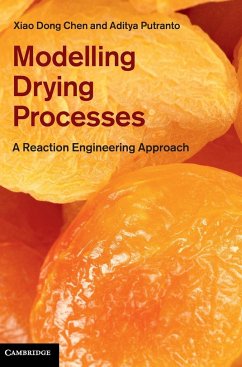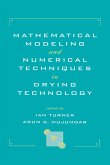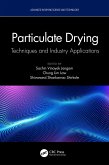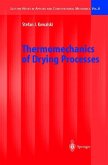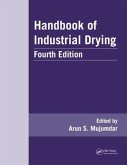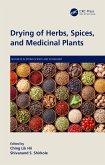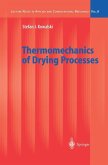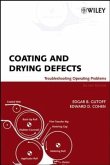- Gebundenes Buch
- Merkliste
- Auf die Merkliste
- Bewerten Bewerten
- Teilen
- Produkt teilen
- Produkterinnerung
- Produkterinnerung
A comprehensive summary of the state of the art in the reaction engineering approach to drying processes, including modelling, experimentation and applications.
Andere Kunden interessierten sich auch für
![Mathematical Modeling and Numerical Techniques in Drying Technology Mathematical Modeling and Numerical Techniques in Drying Technology]() Ian TurnerMathematical Modeling and Numerical Techniques in Drying Technology549,99 €
Ian TurnerMathematical Modeling and Numerical Techniques in Drying Technology549,99 €![Particulate Drying Particulate Drying]() Particulate Drying163,99 €
Particulate Drying163,99 €![Thermomechanics of Drying Processes Thermomechanics of Drying Processes]() Stefan Jan KowalskiThermomechanics of Drying Processes81,99 €
Stefan Jan KowalskiThermomechanics of Drying Processes81,99 €![Handbook of Industrial Drying Handbook of Industrial Drying]() Handbook of Industrial Drying599,99 €
Handbook of Industrial Drying599,99 €![Drying of Herbs, Spices, and Medicinal Plants Drying of Herbs, Spices, and Medicinal Plants]() Drying of Herbs, Spices, and Medicinal Plants210,99 €
Drying of Herbs, Spices, and Medicinal Plants210,99 €![Thermomechanics of Drying Processes Thermomechanics of Drying Processes]() Stefan Jan KowalskiThermomechanics of Drying Processes77,99 €
Stefan Jan KowalskiThermomechanics of Drying Processes77,99 €![Coating and Drying Defects Coating and Drying Defects]() Edgar B. GutoffCoating and Drying Defects207,99 €
Edgar B. GutoffCoating and Drying Defects207,99 €-
-
-
A comprehensive summary of the state of the art in the reaction engineering approach to drying processes, including modelling, experimentation and applications.
Hinweis: Dieser Artikel kann nur an eine deutsche Lieferadresse ausgeliefert werden.
Hinweis: Dieser Artikel kann nur an eine deutsche Lieferadresse ausgeliefert werden.
Produktdetails
- Produktdetails
- Verlag: Cambridge University Press
- Seitenzahl: 254
- Erscheinungstermin: 23. Mai 2013
- Englisch
- Abmessung: 250mm x 175mm x 18mm
- Gewicht: 624g
- ISBN-13: 9781107012103
- ISBN-10: 1107012104
- Artikelnr.: 37294703
- Herstellerkennzeichnung
- Libri GmbH
- Europaallee 1
- 36244 Bad Hersfeld
- gpsr@libri.de
- Verlag: Cambridge University Press
- Seitenzahl: 254
- Erscheinungstermin: 23. Mai 2013
- Englisch
- Abmessung: 250mm x 175mm x 18mm
- Gewicht: 624g
- ISBN-13: 9781107012103
- ISBN-10: 1107012104
- Artikelnr.: 37294703
- Herstellerkennzeichnung
- Libri GmbH
- Europaallee 1
- 36244 Bad Hersfeld
- gpsr@libri.de
Xiao Dong Chen is currently the 1000-talent Chair Professor of Chemical Engineering at Xiamen University in China and the Head of Department of Chemical and Biochemical Engineering. He is also a fractional Professor of Chemical Engineering and the Co-Director of the Biotechnology and Food Engineering Research Lab at Monash University, Australia, and an Elected Fellow of the Royal Society of New Zealand, the Australian Academy of Technological Sciences and Engineering, and the IChemE.
1. Introduction: 1.1. Practical background
1.2. A 'microstructural' discussion of the phenomena of drying of moist porous materials
1.3. The reaction engineering approach (REA) to modeling drying
1.4. Summary
2. Reaction Engineering Approach I: Lumped-REA: 2.1. The REA formulation
2.2. Determination of REA model parameters
2.3. Coupling the momentum, heat and mass balances
2.4. Mass or heat transfer limiting
2.5. Convective drying of particulates or thin layer products modeled using the L-REA
2.6. Convective drying of thick samples modeled using the L-REA
2.7. The intermittent drying of food materials modeled using the L-REA
2.8. The intermittent drying under time-varying temperature and humidity modeled using the L-REA
2.9. The heating of wood under linear-increased gas temperature modeled using the L-REA
2.10. The baking of cake modeled using the L-REA
2.11. The infrared-heating drying of a mixture of polymer solution under time-varying infrared-heating intensity modeled using the L-REA
2.12. The intermittent drying of a mixture of polymer solution under time-varying infrared-heating intensity modeled using the L-REA
2.13. Summary
3. Reaction Engineering Approach II: Spatial-REA: 3.1. The spatial reaction engineering approach (S-REA) formulation
3.2. Determination of the S-REA parameters
3.3. The S-REA for convective drying
3.4. The S-REA for intermittent drying
3.5. The S-REA for wood heating under constant heating rate
3.6. The S-REA for baking of bread
3.7. Summary
4. Comparisons of the REA with Fickian-Type Drying Theories, Luikov's and Whitaker's approach: 4.1. Model formulation
4.2. Boundary conditions' controversies
4.3. Diffusion-based model with the local evaporation rate
4.4. Comparison of the diffusion-based model and the L-REA on the convective drying
4.5. Comparison of the diffusion-based model and the S-REA on the convective drying
4.6. Model formulation of Luikov's approach
4.7. Model formulation of Whitaker's approach
4.8. Comparison of the L-REA, Luikov's and Whitaker's approach for modeling heat treatment of wood under constant heating rate
4.9. Comparison of the S-REA, Luikov's and Whitaker's approach for modeling heat treatment of wood under constant heating rate
4.10. Summary.
1.2. A 'microstructural' discussion of the phenomena of drying of moist porous materials
1.3. The reaction engineering approach (REA) to modeling drying
1.4. Summary
2. Reaction Engineering Approach I: Lumped-REA: 2.1. The REA formulation
2.2. Determination of REA model parameters
2.3. Coupling the momentum, heat and mass balances
2.4. Mass or heat transfer limiting
2.5. Convective drying of particulates or thin layer products modeled using the L-REA
2.6. Convective drying of thick samples modeled using the L-REA
2.7. The intermittent drying of food materials modeled using the L-REA
2.8. The intermittent drying under time-varying temperature and humidity modeled using the L-REA
2.9. The heating of wood under linear-increased gas temperature modeled using the L-REA
2.10. The baking of cake modeled using the L-REA
2.11. The infrared-heating drying of a mixture of polymer solution under time-varying infrared-heating intensity modeled using the L-REA
2.12. The intermittent drying of a mixture of polymer solution under time-varying infrared-heating intensity modeled using the L-REA
2.13. Summary
3. Reaction Engineering Approach II: Spatial-REA: 3.1. The spatial reaction engineering approach (S-REA) formulation
3.2. Determination of the S-REA parameters
3.3. The S-REA for convective drying
3.4. The S-REA for intermittent drying
3.5. The S-REA for wood heating under constant heating rate
3.6. The S-REA for baking of bread
3.7. Summary
4. Comparisons of the REA with Fickian-Type Drying Theories, Luikov's and Whitaker's approach: 4.1. Model formulation
4.2. Boundary conditions' controversies
4.3. Diffusion-based model with the local evaporation rate
4.4. Comparison of the diffusion-based model and the L-REA on the convective drying
4.5. Comparison of the diffusion-based model and the S-REA on the convective drying
4.6. Model formulation of Luikov's approach
4.7. Model formulation of Whitaker's approach
4.8. Comparison of the L-REA, Luikov's and Whitaker's approach for modeling heat treatment of wood under constant heating rate
4.9. Comparison of the S-REA, Luikov's and Whitaker's approach for modeling heat treatment of wood under constant heating rate
4.10. Summary.
1. Introduction: 1.1. Practical background
1.2. A 'microstructural' discussion of the phenomena of drying of moist porous materials
1.3. The reaction engineering approach (REA) to modeling drying
1.4. Summary
2. Reaction Engineering Approach I: Lumped-REA: 2.1. The REA formulation
2.2. Determination of REA model parameters
2.3. Coupling the momentum, heat and mass balances
2.4. Mass or heat transfer limiting
2.5. Convective drying of particulates or thin layer products modeled using the L-REA
2.6. Convective drying of thick samples modeled using the L-REA
2.7. The intermittent drying of food materials modeled using the L-REA
2.8. The intermittent drying under time-varying temperature and humidity modeled using the L-REA
2.9. The heating of wood under linear-increased gas temperature modeled using the L-REA
2.10. The baking of cake modeled using the L-REA
2.11. The infrared-heating drying of a mixture of polymer solution under time-varying infrared-heating intensity modeled using the L-REA
2.12. The intermittent drying of a mixture of polymer solution under time-varying infrared-heating intensity modeled using the L-REA
2.13. Summary
3. Reaction Engineering Approach II: Spatial-REA: 3.1. The spatial reaction engineering approach (S-REA) formulation
3.2. Determination of the S-REA parameters
3.3. The S-REA for convective drying
3.4. The S-REA for intermittent drying
3.5. The S-REA for wood heating under constant heating rate
3.6. The S-REA for baking of bread
3.7. Summary
4. Comparisons of the REA with Fickian-Type Drying Theories, Luikov's and Whitaker's approach: 4.1. Model formulation
4.2. Boundary conditions' controversies
4.3. Diffusion-based model with the local evaporation rate
4.4. Comparison of the diffusion-based model and the L-REA on the convective drying
4.5. Comparison of the diffusion-based model and the S-REA on the convective drying
4.6. Model formulation of Luikov's approach
4.7. Model formulation of Whitaker's approach
4.8. Comparison of the L-REA, Luikov's and Whitaker's approach for modeling heat treatment of wood under constant heating rate
4.9. Comparison of the S-REA, Luikov's and Whitaker's approach for modeling heat treatment of wood under constant heating rate
4.10. Summary.
1.2. A 'microstructural' discussion of the phenomena of drying of moist porous materials
1.3. The reaction engineering approach (REA) to modeling drying
1.4. Summary
2. Reaction Engineering Approach I: Lumped-REA: 2.1. The REA formulation
2.2. Determination of REA model parameters
2.3. Coupling the momentum, heat and mass balances
2.4. Mass or heat transfer limiting
2.5. Convective drying of particulates or thin layer products modeled using the L-REA
2.6. Convective drying of thick samples modeled using the L-REA
2.7. The intermittent drying of food materials modeled using the L-REA
2.8. The intermittent drying under time-varying temperature and humidity modeled using the L-REA
2.9. The heating of wood under linear-increased gas temperature modeled using the L-REA
2.10. The baking of cake modeled using the L-REA
2.11. The infrared-heating drying of a mixture of polymer solution under time-varying infrared-heating intensity modeled using the L-REA
2.12. The intermittent drying of a mixture of polymer solution under time-varying infrared-heating intensity modeled using the L-REA
2.13. Summary
3. Reaction Engineering Approach II: Spatial-REA: 3.1. The spatial reaction engineering approach (S-REA) formulation
3.2. Determination of the S-REA parameters
3.3. The S-REA for convective drying
3.4. The S-REA for intermittent drying
3.5. The S-REA for wood heating under constant heating rate
3.6. The S-REA for baking of bread
3.7. Summary
4. Comparisons of the REA with Fickian-Type Drying Theories, Luikov's and Whitaker's approach: 4.1. Model formulation
4.2. Boundary conditions' controversies
4.3. Diffusion-based model with the local evaporation rate
4.4. Comparison of the diffusion-based model and the L-REA on the convective drying
4.5. Comparison of the diffusion-based model and the S-REA on the convective drying
4.6. Model formulation of Luikov's approach
4.7. Model formulation of Whitaker's approach
4.8. Comparison of the L-REA, Luikov's and Whitaker's approach for modeling heat treatment of wood under constant heating rate
4.9. Comparison of the S-REA, Luikov's and Whitaker's approach for modeling heat treatment of wood under constant heating rate
4.10. Summary.

